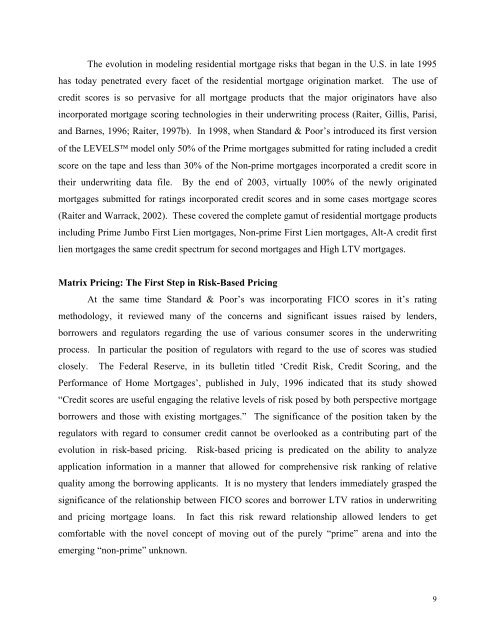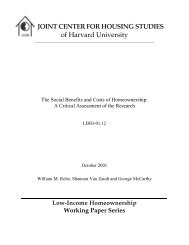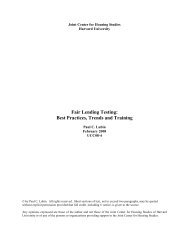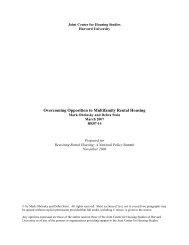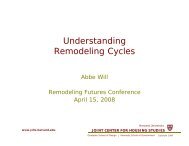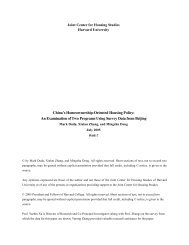Untitled - Joint Center for Housing Studies - Harvard University
Untitled - Joint Center for Housing Studies - Harvard University
Untitled - Joint Center for Housing Studies - Harvard University
You also want an ePaper? Increase the reach of your titles
YUMPU automatically turns print PDFs into web optimized ePapers that Google loves.
The evolution in modeling residential mortgage risks that began in the U.S. in late 1995<br />
has today penetrated every facet of the residential mortgage origination market. The use of<br />
credit scores is so pervasive <strong>for</strong> all mortgage products that the major originators have also<br />
incorporated mortgage scoring technologies in their underwriting process (Raiter, Gillis, Parisi,<br />
and Barnes, 1996; Raiter, 1997b). In 1998, when Standard & Poor’s introduced its first version<br />
of the LEVELS model only 50% of the Prime mortgages submitted <strong>for</strong> rating included a credit<br />
score on the tape and less than 30% of the Non-prime mortgages incorporated a credit score in<br />
their underwriting data file. By the end of 2003, virtually 100% of the newly originated<br />
mortgages submitted <strong>for</strong> ratings incorporated credit scores and in some cases mortgage scores<br />
(Raiter and Warrack, 2002). These covered the complete gamut of residential mortgage products<br />
including Prime Jumbo First Lien mortgages, Non-prime First Lien mortgages, Alt-A credit first<br />
lien mortgages the same credit spectrum <strong>for</strong> second mortgages and High LTV mortgages.<br />
Matrix Pricing: The First Step in Risk-Based Pricing<br />
At the same time Standard & Poor’s was incorporating FICO scores in it’s rating<br />
methodology, it reviewed many of the concerns and significant issues raised by lenders,<br />
borrowers and regulators regarding the use of various consumer scores in the underwriting<br />
process. In particular the position of regulators with regard to the use of scores was studied<br />
closely. The Federal Reserve, in its bulletin titled ‘Credit Risk, Credit Scoring, and the<br />
Per<strong>for</strong>mance of Home Mortgages’, published in July, 1996 indicated that its study showed<br />
“Credit scores are useful engaging the relative levels of risk posed by both perspective mortgage<br />
borrowers and those with existing mortgages.” The significance of the position taken by the<br />
regulators with regard to consumer credit cannot be overlooked as a contributing part of the<br />
evolution in risk-based pricing. Risk-based pricing is predicated on the ability to analyze<br />
application in<strong>for</strong>mation in a manner that allowed <strong>for</strong> comprehensive risk ranking of relative<br />
quality among the borrowing applicants. It is no mystery that lenders immediately grasped the<br />
significance of the relationship between FICO scores and borrower LTV ratios in underwriting<br />
and pricing mortgage loans. In fact this risk reward relationship allowed lenders to get<br />
com<strong>for</strong>table with the novel concept of moving out of the purely “prime” arena and into the<br />
emerging “non-prime” unknown.<br />
9


